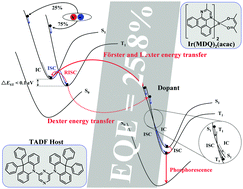An effective host material with thermally activated delayed fluorescence formed by confined conjugation for red phosphorescent organic light-emitting diodes†
Abstract
A thermally activated delayed fluorescence material 2,6-bis(9,9-diphenylacridin-10(9H)-yl)pyrazine was designed and synthesized. The twisted configuration made it possesses very small singlet–triplet splitting. A red electroluminescent device based on this new host material is able to achieve ∼26% external quantum efficiency and relatively flat efficiency roll-off.

- This article is part of the themed collection: SU 120: Celebrating 120 Years of Soochow University

 Please wait while we load your content...
Please wait while we load your content...